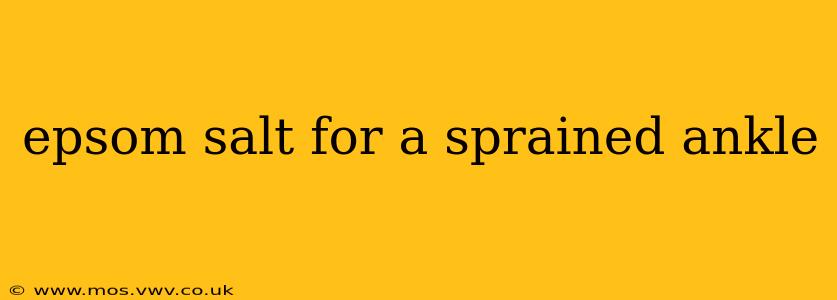A sprained ankle, that agonizing twist of fate that leaves you hobbled and in pain, is a common injury. While immediate medical attention is crucial for severe sprains, many find solace and support in home remedies like Epsom salt soaks. But does this readily available mineral really help? Let's delve into the benefits, methods, and cautions surrounding Epsom salt's use for sprained ankles.
What is a Sprained Ankle?
Before we explore the Epsom salt remedy, let's understand the injury itself. A sprained ankle occurs when the ligaments supporting your ankle joint are stretched or torn. This typically happens due to a sudden twisting or rolling of the foot. The severity ranges from mild (minor stretching) to severe (complete ligament tear). Symptoms include pain, swelling, bruising, stiffness, and difficulty bearing weight.
Does Epsom Salt Help a Sprained Ankle?
Epsom salt, chemically known as magnesium sulfate, is a naturally occurring compound. When dissolved in water, it creates a soak that's believed to offer several benefits for sprained ankles:
- Reduces Swelling: The magnesium in Epsom salt is thought to help draw excess fluid from the tissues, thus reducing swelling and inflammation.
- Eases Pain: The warmth of the water and the magnesium sulfate may have a mild analgesic effect, providing some pain relief.
- Relaxes Muscles: Magnesium plays a crucial role in muscle function, and a soak might help relax the surrounding muscles, easing stiffness and discomfort.
It's crucial to understand that Epsom salt is a supportive therapy, not a cure. It can help manage symptoms, but it won't repair the damaged ligaments.
How to Use Epsom Salt for a Sprained Ankle
Using Epsom salt for a sprained ankle is straightforward:
- Dissolve Epsom Salt: Add 2 cups of Epsom salt to a basin or tub filled with warm (not hot) water. Make sure the salt is completely dissolved.
- Soak Your Ankle: Submerge your injured ankle in the solution for 15-20 minutes.
- Repeat: Repeat this process 2-3 times a day, or as needed, for pain relief.
- Elevation: After the soak, elevate your ankle above your heart to reduce swelling.
What are the Potential Side Effects?
While generally safe, some individuals might experience mild skin irritation from Epsom salt soaks. If you notice any redness, itching, or burning, discontinue use and consult your doctor. Also, be cautious if you have any open wounds on your ankle.
How Long Does it Take to See Results?
The time it takes to notice relief varies from person to person. Some might feel immediate pain reduction and reduced swelling, while others may need several soaks before noticing any significant improvement.
When Should I See a Doctor for a Sprained Ankle?
While Epsom salt soaks can provide temporary relief, it's essential to seek medical attention if your sprain is severe. Consult a doctor immediately if you experience:
- Intense pain
- Inability to bear weight
- Significant swelling
- Deformity of the ankle
- Numbness or tingling
- Persistent pain after several days of home treatment
Can I Use Epsom Salt Soaks for Other Injuries?
Epsom salt soaks are sometimes used for other musculoskeletal issues like muscle soreness, aches, and stiffness. However, it's crucial to consult a healthcare professional before using it for any other condition, especially if you have underlying health problems.
What Other Home Remedies Can I Try?
Beyond Epsom salt soaks, other home remedies for sprained ankles include:
- RICE method: Rest, Ice, Compression, Elevation.
- Over-the-counter pain relievers: Ibuprofen or naproxen can help manage pain and inflammation.
- Gentle range-of-motion exercises: Once the initial swelling subsides, gentle exercises can help restore ankle mobility.
Remember, these home remedies are supportive measures. Proper medical evaluation and treatment are essential for a full recovery, particularly for moderate to severe sprains. Always prioritize professional medical advice for any injury.
